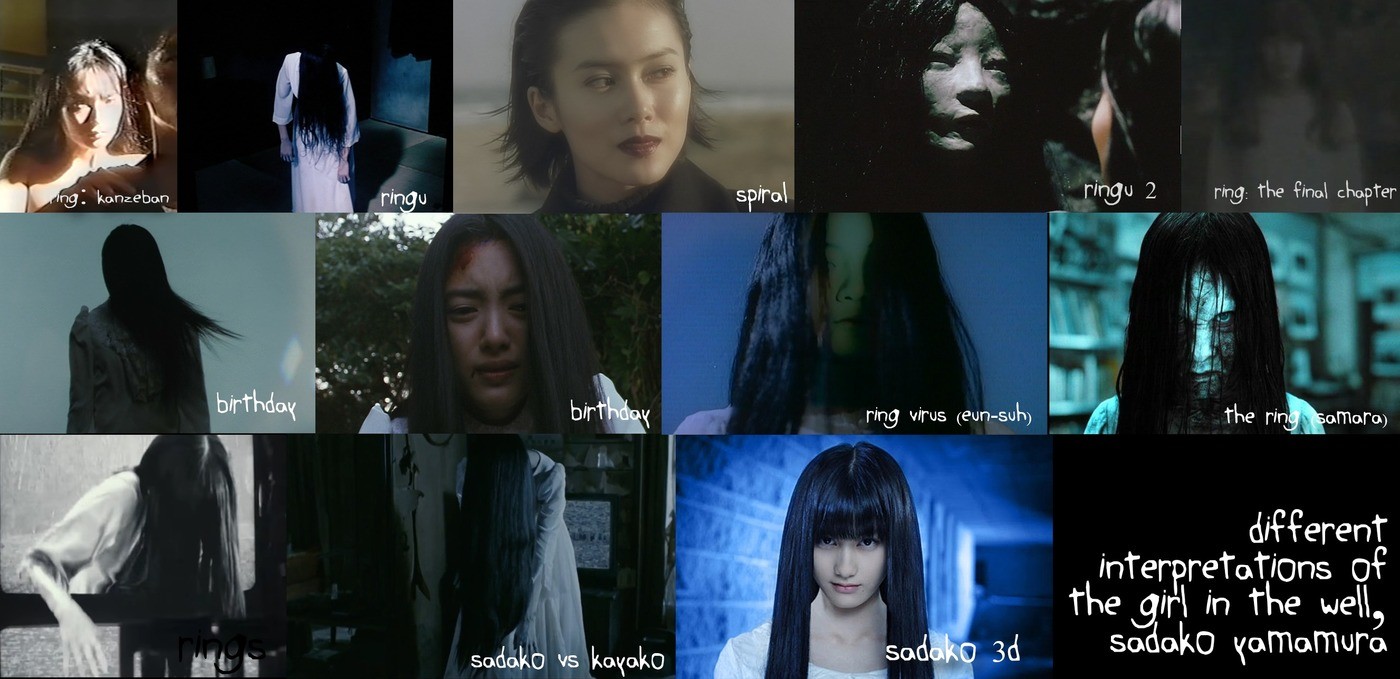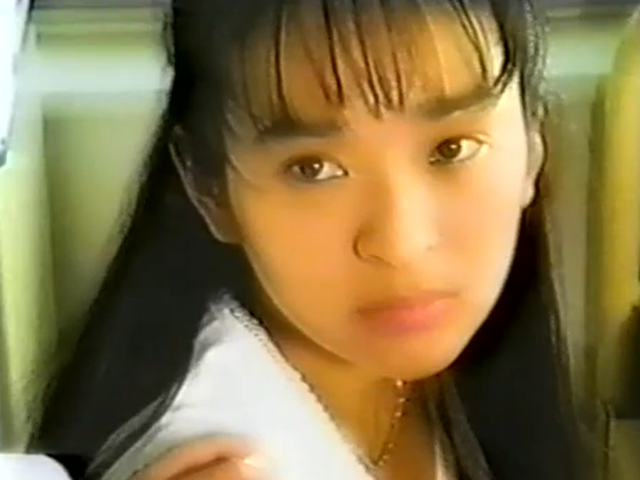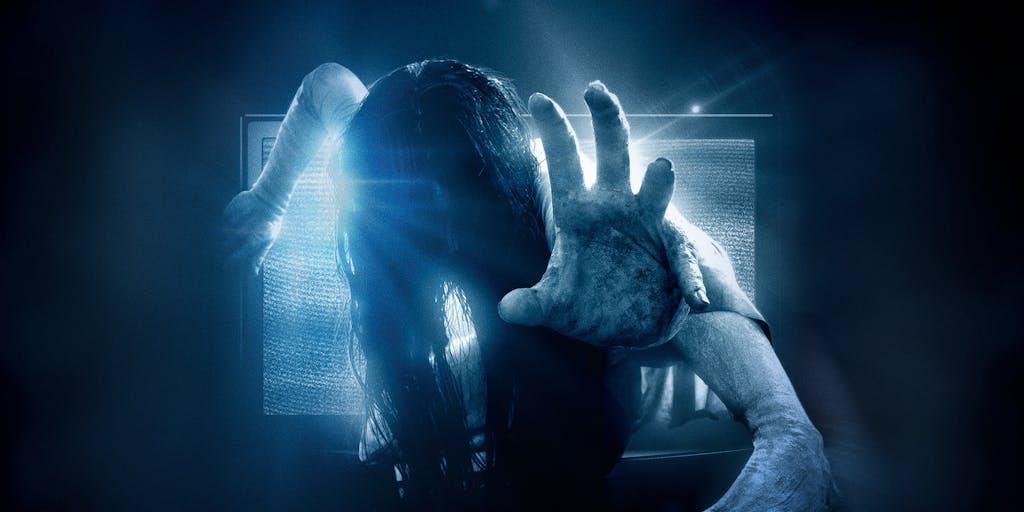The
Ring franchise is considered a founding factor in the interest in
Japanese horror in the west, or rather, creating a string of mostly unnecessary
remakes. Based on a series of novels written by Koji Suzuki (also author of Dark Water), the story of a spooky
cursed videotape that kills anyone after seven days, has captured or rather
terrorised the imagination of readers and viewers alike. Though the first book
was a mystery horror, the sequels, Spiral
and Loop, were a medical mystery, and
a science fiction respectively. All have engaging stories and fantastic plot
twists that explore the sinister virus that originates from the videotape,
rather than a haunting curse as depicted in the movies.
Ring: Kanzenban (1995)
Ring: Kanzenban was the first attempt to adapt Ring as a TV serial, but is a poor attempt
with signs of a lack of a budget. Though a close adaptation of the book, it
does take bizarre liberties, and has a strange focus on being everything but a
horror story. Kazuyuki Asakawa (Katsunori Takahashi), a journalist,
investigates the mysterious death of niece, discovering the existence of a
cursed videotape, which he watches, and learns he has seven days to live. He
teams up with his friend Ryuji Takayama (Yoshio Harada), Asakawa investigates
the tape’s origins, leading him to the psychic Sadako Yamamura (Ayane Miura),
thrown down a well long ago. Aside from the incredibly poor quality, the TV
series decides to throw in some more adult content at the expense of telling a
decent mystery.
Ring: The Final Chapter (1999)
Yes, this
did come out a year after the 1998 Japanese movie, but it made sense to review
it before getting to the movies. Ring:
The Final Chapter is one of two TV series adapting the books, with a few
liberties, and inspiration from the film. Not a clue why it is called “The
Final Chapter” since this is one of many chapters in The Ring’s chronicles. It
follows the story of the novel and film, though the cursed videotape is
reimagined as a recording of a pop idol’s music video, extending the countdown
to death to roughly two weeks. Asakawa (Toshiro Yanagiba) is a lot more
likeable now compared to Kanzenban’s
whiny version. The series meanders quite a lot, drags its feet, and Tomoya
Nagase as the weirdest portrayal of Ryuji Takayama yet. Had a limited budget,
feels a little sluggish, and has pacing issues, but is a good show altogether.
Rasen: The Series (1999)
The sequel
to The Final Chapter, Rasen is based on the second novel Spiral. Like the first season, it takes
a lot of liberties with the story. Rasen
involves a teacher, Mitsuo Ando, a bereaved father, investigating the cursed
videotape (now on CD!), and the biological mysteries of Sadako’s genes, that
can create clones of the dead. Okay, it’s a bit more complicated than that, but
that is the short version. It gives the characters some great moments of
jeopardy, and hard choices to make between their loved ones and the world. By
far, the best part of the series in the King of Terror subplot, a
murder-mystery terrorism plot involving a sinister figure manipulating
characters behind the scenes. It is fun trying to guess who this character
actually is, and their origins are even more terrifying than those of Sadako
Yamamura.
Ring (1998)
The
synonymous Japanese horror film, Ring propelled western interest in Asian
horror, leading to a string of remakes. The film was directed by Hideo Nakata,
who also directed the sequel, the American sequel, and the brilliant Dark
Water. Perhaps the greatest element of the movie is its chilling atmosphere and
frights, projecting a constant sense of dread throughout. This sort of scare
makes for a much better horror film than cheap jump scares. There is an obvious
budget, but the use of special effects works fine for the time. Negative shots
are used to symbolise death, etc. My one complaint is that the DVD copy I have
is ridiculously dark and grainy in some places, particularly in the night
scenes, making it hard to tell what's going on.
Asakawa is
reimagined as a woman, Reiko Asakawa (Nanako Matsushima), a workaholic
journalist. She has a young psychic son named Yoichi, and Ryuji Takayama
(Hiroyuki Sanada) is her ex-husband. The film’s plot takes a lot of liberties
with the novel, rewriting Sadako’s backstory too. As a child, she murdered a
journalist, her mother went nuts and committed suicide by throwing herself into
a volcano, and Sadako is eventually thrown down a well by her father Dr. Ikuma.
The film has heavy themes of parental neglect, responsibility, and examines the
climate of Japanese society at the time.
The film
has a lot of chills. It is implied that the ghosts of Sadako’s victims become
her slaves. The cursed videotape itself feels alien in tone, with abnormal
visuals and sounds. Of course, the highlight is Sadako emerging from the
television. She was played by kabuki actress Rie Ino, whose creepy movements
were then played backgrounds to give Sadako an inhuman quality about her. The
score was composed by Kenji Kawai, who also did the score for Ghost in the
Shell. Ring is a fantastic film, and in my opinion, one of the best horror
films made. The film gained a prequel, and two sequels, though the first of
which was retconned.
Rasen (1998)
Not many
people are aware of this film. It was originally the direct sequel to Ring,
released mere weeks after the original in order to keep public interest in the
franchise. Only problem was no one went to see it, or knew it was in cinemas.
It is a close adaptation of the book Spiral, abandoning the more supernatural
elements in favour of a medical mystery. Lacking scares and naff quality, Rasen
revealed the cursed videotape contains a mutated virus which can cause heart
failure, but also can cause a fast-paced mystical pregnancy in women if they
conceive during their cursing. Sadako, played wonderfully by Saeki Hinako, is
back from the dead and offers the hero, Mitsuo Ando, the chance to resurrect
his dead son, but at the cost of spreading the videotape across the world.
Though it has some interesting ideas, the film’s quality and completely
differentiation from Ring made it unpopular. It was subsequently retconned and
a new film, directed by Hideo Nakata, was made: Ring 2.
Ring 2 (1999)
The new sequel to Ring, Ring 2 is better than Rasen but does have its own share of problems. There is a lot going on in the film, bringing back the whole cast of the original, and takes place two weeks after. Ryuji Takayama is dead, Asakawa and Yoichi are missing, and her elderly father has died after watching the tape. Mai Takano (Miki Nakatani), Ryuji’s student, searches for answers to his death, tracking down Asakawa and Yoichi, who has become mute and his powers are influenced by Sadako’s power. There are a lot of subplots in the film – a mad scientist hopes to master psychic energy; Sadako’s uncle has to collect her body (revealing Sadako was actually alive in the well for thirty years!); and a journalist named Okazaki dooms both himself and a teenager when he begins researching the cursed videotape and makes cowardly moves to save his own skin. The finale is certainly a weird one, but ends with a briefly touching moment where Sadako confronts the heroes as they escape the well, and gives in to her fate as being trapped forever. Ring 2 has a lot of problems, particularly with pacing, isn’t very scary aside from a couple of scenes, and deflates once the whole “Exorcist but with psychic energy and a swimming pool” subplot takes centre stage.
Ring 0 (2000)
A prequel
to the first film, Ring 0 is based on the short story “The Birthday”, detailing
Sadako’s time in a theatre troupe and even fell in love with a young man named
Hiroshi Toyama. Ring 0 is effectively a Japanese remake of Carrie – a socially
ostracized girl has immense psychic powers, finds love, something goes wrong,
and she kills everybody. Though, I actually like this film more than Carrie.
Sadako Yamamura is the protagonist of the film, played wonderfully by Yukie
Nakama, a shy introvert who hides her shady past and just wants to be an
actress. She falls in love with Toyama, the sound operator, and their romance
is rather sweet. Things go to hell in the third act, involving a vengeful
journalist orchestrating Sadako’s murder, but she is revived when it turns out
she has an evil twin living with her father. In a wild plot twist, turns out
Sadako split into two identical twins, one good and one evil, the latter
tormenting the good Sadako for years. The film then goes from absolutely
terrifying to tearjerking towards the
end, as you know, Sadako is inevitably going to be thrown down a well and
become the vengeful ghost we know and fear.
The Japanese film was such a success that South Korea decided to remake it a year after it came out. The Ring Virus is unfortunately a total dullfest. It directs the novel a little closer, mixing various elements from virtually all the past adaptations of the book, including the dodgy incest stuff from Kanzenban. The Korean version of Reiko Asakawa is emotionless and rigid, and her actress never comes off as having any interest in giving a good performance. Even when she watches the videotape, she looks bored, and somehow even makes throwing up in a toilet looked staged. Even the scene where Sadako (or Park Eun-Suh) emerges from a TV is rubbish. Why did the cinematographer think having a bright room would be a menacing setting for the iconic shot of the movie? Awful stuff.
The Ring (2002)
And now
onto the other main event. The American remake of Ring is probably better known
than the Japanese film, and in some ways, is better, or at least in quality.
Directed by Gore Verbinski and produced by Jerry Bruckheimer, The Ring is a
mostly superb adaptation, with a chilling atmosphere, likeable characters, and
aside from a couple of jumpscares, has some great spooky moments. Naomi Watts
carries most of the film as Rachel Keller (i.e. Asakawa), following the basic
plot of the cursed videotape, etc. She has a strangely creepy son named Aidan (David Dorfman),
who reminds me of Haley Joel Osment’s character in The Sixth Sense. This kid
even finds out the important plot details later and decides NOT to inform his
mother of these dreadful twists until its too late.
The cursed
videotape is like something from David Lynch or David Cronenberg. Sadako is
reworked as Samara Morgan (Daveigh Chase), a delightfully creepy little girl
who “never sleeps”, and has uncontrolled psychic powers that drove her foster
parents crazy, murdering all their prize-winning horses after she was locked in
the barn. The film rather cleverly sets up Samara as an innocent victim with
powers she has no control over. But, then in the final scenes, it is implied
Samara is actually a total sociopath, manipulating Rachel and the audience all
along. The sombre violin-based score by Hans Zimmer is great, and the film is
forever shot in this slightly blue tint, like a dated videotape. The film also
pays homages to Alfred Hitchcock throughout the film. The film was followed by
a short film tying the sequel to it, and then would gain another sequel in
2017.
Rings (2005 short film)
This decent
short film is set between the first and second American movies, following a
rather idiotic boy as he joins a cult that watches Samara’s videotape in turn
and record what they experience. The short was directed by Jonathan Liebesman
of all people, who’d direct the 2014 Teenage Mutant Ninja Turtles films. How
did he go from this to that? The film does well to create a sense of mystery
about the tape, studying the impact of trends and urban legends on the young.
There are genuine frights in the film, it makes for a good psychological drama,
with Samara at her scariest. Still, that moment when a character vomits up a
giant CGI centipede takes you out of the movie.
The Ring Two (2005)
The Ring
Two is a sequel that doesn’t know its own identity. Gore Verbinski was
directing Pirates of the Caribbean, so Hideo Nakata was brought in to direct.
The end result is a bit of a palaver, trying and failing to mix the western and
eastern horror traditions together. Rachel and Aidan have moved to Oregon, but
Samara somehow tracks them down with the intent on making Rachel her new mother
by possessing Aidan's body. While the audience kinda figures out what’s going on,
Rachel takes half the movie to. Samara breaks her own established rules in
order to possess Aidan, and ends up attracting the attention of killer CGI
deer. Yes, killer deer. Rachel eventually tracks down Samara’s biological
mother, Evelyn, played by noneother than Sissy Spacek. The Carrie similarities
have come full circle.
Sadako 3D (2012)
Twelve
years after the last Ring film, Sadako Yamamura returned to her native country
in a new 3D film that is weird to say the least, and not in a good way.
In someway a soft reboot, Sadako 3D is a tacky and very silly film that felt
like an excuse to just make a 3D film using an established franchise. The worst
element is the titular 3D element, and constantly relies on Sadako crawling out
of televisions to spook the audience. It’s like the filmmakers never watched
the past movies, and only know the character from iconography alone.
Sadako 2 (2014)
The sequel
to Sadako 3D is slightly better, but still has a lot of problems. Akane falls
pregnant and apparently dies, leaving her daughter Nagi in the care of
Takanori’s sister Fuko. Nagi is a creepy girl to say the least, and it is
quickly implied that she may be the reborn Sadako, murdering people. Fuko is
dealing with her own trauma, having witnessed her mother’s suicide years ago,
and isn’t very welcoming to death. The cursed videotape has evolved into
pushing people into killing themselves, and Seiji Kashiwada has been arrested
facing execution. A lot of the time, Sadako 2 has a melancholic mood, but
manages to tell a relatively decent story. Unfortunately, there is a larger
plot going on that is never really explained, too many unanswered questions
that appear to be setting up unfulfilled sequels, and the film wastes too much
time floundering around trying to figure out what to do.
Sadako vs. Kayako (2016)
A crossover
between Ring and the Ju-On/The Grudge franchise. This has a lot of potential,
bringing together Japan’s most scariest ghosts – Sadako and Kayako Saeko, but
unfortunately wastes it. Though the film succeeds in capturing the sense of
dread both prominent horror franchises have, the actual crossover event doesn’t
happen until the last ten minutes. Two girls are separately cursed by the
titular ghosts, eventually leading them to team up with an exorcist, who
suggests being cursed twice and make Sadako and Kayako fight each other, to
cancel out the curses. There are a couple of effective scenes, like when a bullied
boy uses Kayako’s haunted house to get revenge on his tormentors. The fight
itself between Sadako and Kayako is brief but pretty great fun, showing their
conflicting powers. And the ending is equally bizarre but a set up for
something awesome that we’ll probably never get to see.
Rings (2017)
The
beleaguered third film in the American series, Rings, may have come a bit too
late to be relevant, but it is a good film. Taking inspiration from the short film, Rings involves a young woman
named Julia (Matilda Lutz) discovering her college boyfriend Holt (Alex Roe) is
part of the cursed videotape cult, now reimagined as a social experiment
orchestrated by Leonard off The Big Bang Theory. With Holt running out of time,
Julia decides to watch Samara’s videotape herself and becomes cursed. But, her
video experience is a little different from the others, viewing a new version
of the tape, and gains a strange mark on her hand. It eventually becomes clear
that Samara wants Julia and Holt to find and bury her mortal remains. Very
continuity heavy, the film explores more of Samara’s backstory, with Vincent
D’Onofrio appearing as Samara’s blind, evil, reverend father. Not exactly the
backstory that I had expected, but it’s okay. The film takes a lot of visuals
and influence from The Ring, using Hans Zimmer’s old score, and succeeds in
making Samara scary again, even answering a couple of questions about Samara’s
powers and restrictions that could be considered plot holes.










No comments:
Post a Comment